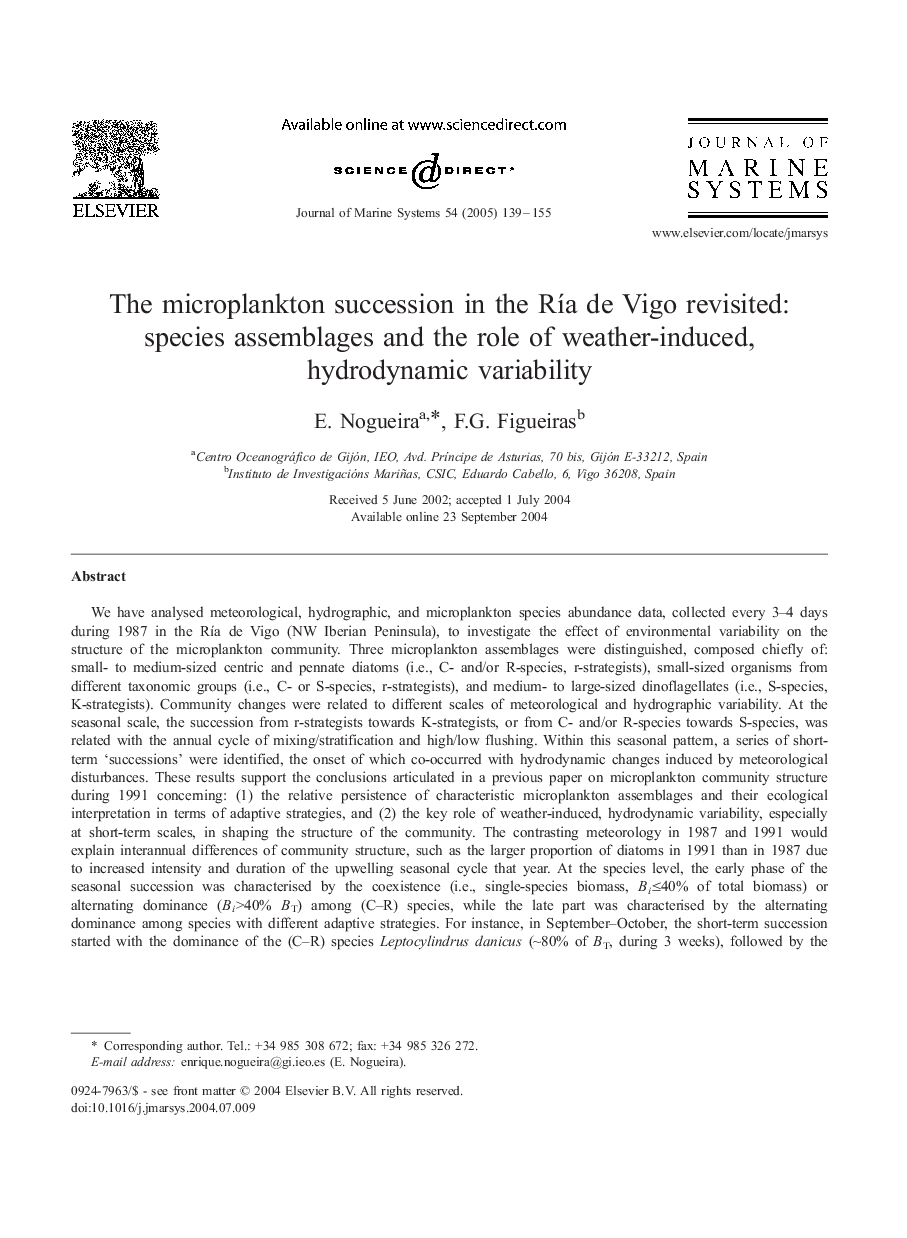| کد مقاله | کد نشریه | سال انتشار | مقاله انگلیسی | نسخه تمام متن |
|---|---|---|---|---|
| 9483446 | 1627378 | 2005 | 17 صفحه PDF | دانلود رایگان |
عنوان انگلیسی مقاله ISI
The microplankton succession in the RÃa de Vigo revisited: species assemblages and the role of weather-induced, hydrodynamic variability
دانلود مقاله + سفارش ترجمه
دانلود مقاله ISI انگلیسی
رایگان برای ایرانیان
موضوعات مرتبط
مهندسی و علوم پایه
علوم زمین و سیارات
اقیانوس شناسی
پیش نمایش صفحه اول مقاله

چکیده انگلیسی
We have analysed meteorological, hydrographic, and microplankton species abundance data, collected every 3-4 days during 1987 in the RÃa de Vigo (NW Iberian Peninsula), to investigate the effect of environmental variability on the structure of the microplankton community. Three microplankton assemblages were distinguished, composed chiefly of: small- to medium-sized centric and pennate diatoms (i.e., C- and/or R-species, r-strategists), small-sized organisms from different taxonomic groups (i.e., C- or S-species, r-strategists), and medium- to large-sized dinoflagellates (i.e., S-species, K-strategists). Community changes were related to different scales of meteorological and hydrographic variability. At the seasonal scale, the succession from r-strategists towards K-strategists, or from C- and/or R-species towards S-species, was related with the annual cycle of mixing/stratification and high/low flushing. Within this seasonal pattern, a series of short-term 'successions' were identified, the onset of which co-occurred with hydrodynamic changes induced by meteorological disturbances. These results support the conclusions articulated in a previous paper on microplankton community structure during 1991 concerning: (1) the relative persistence of characteristic microplankton assemblages and their ecological interpretation in terms of adaptive strategies, and (2) the key role of weather-induced, hydrodynamic variability, especially at short-term scales, in shaping the structure of the community. The contrasting meteorology in 1987 and 1991 would explain interannual differences of community structure, such as the larger proportion of diatoms in 1991 than in 1987 due to increased intensity and duration of the upwelling seasonal cycle that year. At the species level, the early phase of the seasonal succession was characterised by the coexistence (i.e., single-species biomass, Biâ¤40% of total biomass) or alternating dominance (Bi>40% BT) among (C-R) species, while the late part was characterised by the alternating dominance among species with different adaptive strategies. For instance, in September-October, the short-term succession started with the dominance of the (C-R) species Leptocylindrus danicus (â¼80% of BT, during 3 weeks), followed by the (S-R) species Ceratium fusus+Ceratium furca (â¼70% of BT, 1 week), and finished with the dominance of small microheterotrophs (â¼70% of BT, 2 weeks).
ناشر
Database: Elsevier - ScienceDirect (ساینس دایرکت)
Journal: Journal of Marine Systems - Volume 54, Issues 1â4, February 2005, Pages 139-155
Journal: Journal of Marine Systems - Volume 54, Issues 1â4, February 2005, Pages 139-155
نویسندگان
E. Nogueira, F.G. Figueiras,